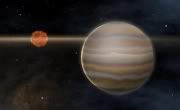First Extrasolar Planet
First Planet Outside Solar System ObservedBy ALICIA CHANG, AP Science Writer Sat Apr 30,10:59 AM ETLOS ANGELES - New images taken of an object five times the mass of Jupiter confirm that it is a giant planet closely orbiting a distant star, an international team of astronomers reported. The team of European and American astronomers said this is the first time a planet outside of our solar system has been directly observed — a claim other scientists have also made. The team first spotted the object last year as a faint reddish speck of light circling a dim brown dwarf — or failed star — 225 light-years away from Earth near the constellation Hydra. At the time, scientists guessed the faint light was a planet, but said further observation was needed. The discovery touched off a debate over whether the object was actually a planet or a background star. Since the mid-1990s, scientists have discovered more than 130 of these so-called extrasolar planets by indirect means, but observing them directly has proved difficult. Refined images taken earlier this year by the Very Large Telescope in northern Chile show two separate objects bound by gravity moving together according to Gael Chauvin, an astronomer at the European Southern Observatory, who led the team.  "Our new images show convincingly that this really is a planet, the first planet that has ever been imaged outside of our solar system," Chauvin said in a statement. Added Benjamin Zuckerman, an astronomer at the University of California, Los Angeles, who was part of the team: "I'm more than 99 percent confident." Chauvin's team estimated the mass of the object, called 2M1207b, by measuring its brightness. They found that it was five times the mass of Jupiter and orbited a brown dwarf, known as 2M1207A, at a distance nearly twice as far as Neptune is from the sun. Their observations will be published in a future issue of Astronomy and Astrophysics, the scientists said. Lynne Hillenbrand, an assistant professor of astronomy at the California Institute of Technology, said the findings were intriguing, but cautioned against calling the object a planet. "The claim of an object being a planet is subject to one's definition of planet and there are different camps on what that definition is," Hillenbrand said. In recent months, different groups of astronomers have published competing claims about directly observing extrasolar planets. Earlier this month, German astronomers published a photograph of an object 450 light-years from Earth that they claimed was the first direct image of an extrasolar planet. But astronomers sparred over the photo, saying that it was possible that it could be a brown dwarf based on the object's mass. Last month, scientists using NASA's Spitzer Space Telescope said they directly measured light from two known Jupiter-sized gas planets orbiting distant stars, but did not get images of the planets separate from their stars. |

















<< Home